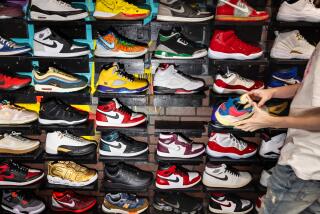BODY WATCH : Smart Steps for Buying Workout Shoes
- Share via
Choosing a pair of workout shoes from this season’s bumper crop can make buying a car seem simple.
The easy part--telling the salesperson which type of shoe you need--is followed by the overwhelming part: being steered to displays of basketball, running, aerobic, walking, tennis, cycling or cross trainer shoes.
“We have almost 250 styles of athletic shoes,” says Erin Kendrigan of Nike. Other manufacturers’ tallies are also high.
Reading advertisements--which seem to promise not just comfort but Olympic-like performance--complicates shopping.
*
What’s New: This season’s shoes have “memory-cushion” insoles and tongue designs to prevent “tongue migration.” For safety, there are shoes that light up with each step (not all use the mercury recently banned in shoes sold in Minnesota). More shoes are laceless, fastened instead with straps.
The emphasis on good cushioning, support and lightweight materials continues. “Wearing even an ounce or two lighter shoes, you feel more efficient,” says Tom Brunick, director of the Athlete’s Foot Weartest Center at North Central College, Naperville, Ill. “An ounce on the foot is like a pound on the hip.”
Several companies now offer money-back guarantees. Cherokee, which makes Rockers walking shoes, allows shoppers to take the shoes for a 45-day walk test. Other manufacturers promise to replace shoes if they wear out before six months. Some stores allow customers to buy two different-sized shoes.
*
What’s Selling: No-lace running shoes, non-twist tongues and lightweight insoles are in demand, says a salesman at a large San Fernando Valley sporting goods chain.
*
The Shopping Checklist: To find the best shoes for you:
* Take your old athletic shoes with you. “They have a story to tell,” Brunick says--if, of course, your salesperson knows how to read them properly. A good one can tell, for instance, if your feet over-pronate (tend to roll inward) and might suggest a style designed to compensate.
* Shop at the end of the day, when feet are generally biggest.
* Have your feet measured from time to time, because they can lengthen and widen with age.
* Pay attention to how the shoes feel. “Comfort is the most important,” says Michael Levi, a Santa Monica podiatrist on staff at St. John’s Hospital and Health Center. Although the very best-fitting shoes require no breaking in, some shoes take a while to feel comfortable.
* Allow a quarter-inch of room from the longest toe to the shoe’s end, Levi says.
* If you are a larger person, look for a thick mid-sole (the cushioning material atop the outsole, or very bottom). The extra shock absorption can reduce injury risk.
* Walk around in a shoe before you buy it, or if possible, mimic the motions of your workout--jumping in basketball shoes, serving in tennis shoes. Some stores have set up treadmills for walkers and runners.
* Don’t scrimp. Plan to spend about $60 for good workout shoes, Levi says.
*
Protecting Your Purchase: “Use athletic shoes only for athletics,” Levi suggests. They’ll last much longer. Once you find a brand and style, stick with it to minimize foot problems.
*
Trade-In Time: To avoid foot problems, know when it’s time for a new pair. “Every four to six months, or every 300 miles, whichever comes first,” Levi says.
Oh, My Aching Dogs: Sign: Possible Cause Blisters: Shoe too small Blackened toenails: Shoe-box area too small Corns: Shoe too narrow Feet hurt after two or three wearings: Wrong shoe for your foot






